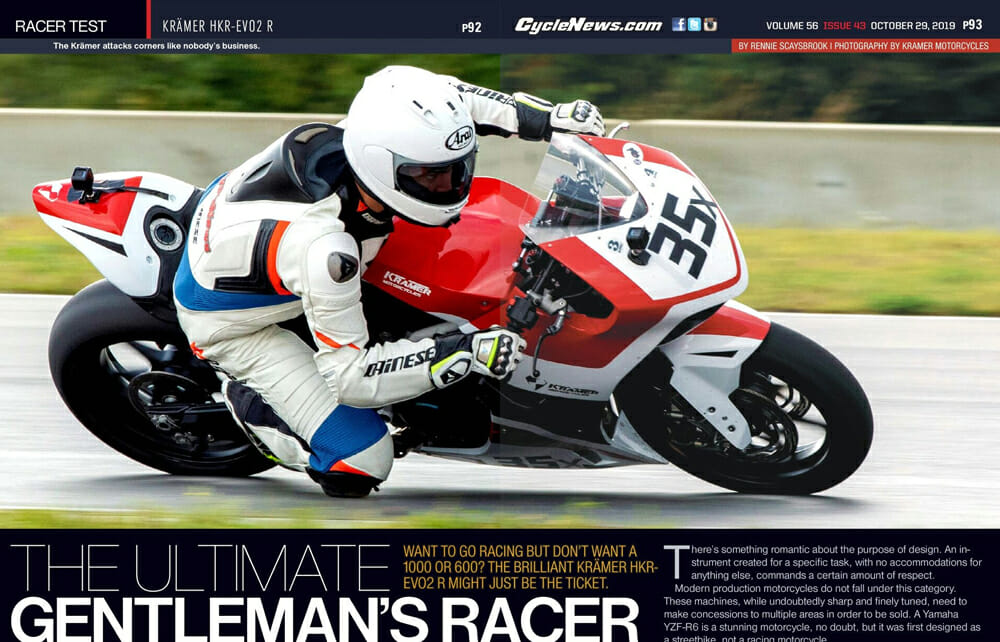Rennie Scaysbrook | November 1, 2019
Want to go racing but don’t want a 1000 or 600? The brilliant Krämer HKR-EVO2 R might just be the ticket.
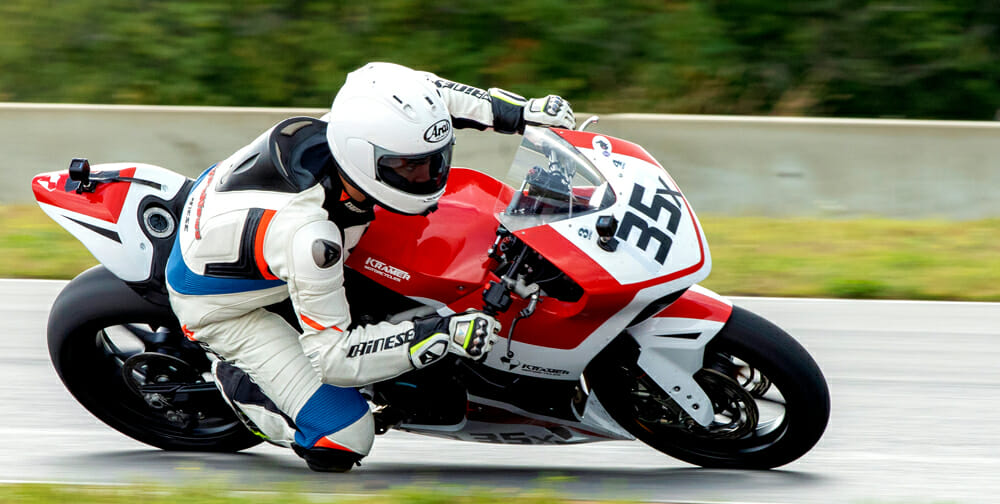 The Krämer attacks corners like nobody’s business.
The Krämer attacks corners like nobody’s business.
Photography by Kramer Motorcycles
There’s something romantic about the purpose of design. An instrument created for a specific task, with no accommodations for anything else, commands a certain amount of respect.
Modern production motorcycles do not fall under this category. These machines, while undoubtedly sharp and finely tuned, need to make concessions to multiple areas in order to be sold. A Yamaha YZF-R6 is a stunning motorcycle, no doubt, but it was first designed as a streetbike, not a racing motorcycle.
Enter Krämer Motorcycles. Founded in 2013, Germany, and the brainchild of former KTM chassis engineers Christof Henco, Markus Krämer, and Nico Rothe, Krämer Motorcycles create pure racing motorcycles for the discerning competitor—these are pure prototype machines, cut from the same design philosophy as what you will find in the Grand Prix paddocks of the world, especially in Moto2 and Moto3.
Time has moved quickly for Kramer. In the five years since the company’s foundation, three models have been developed in the HKR-EVO1, HKR-EVO2, and this HKR-EVO2 R you see on the pages before you. Powered by a stock KTM 690 Duke LC4 single-cylinder motor that pumps out a claimed 80 hp, the HKR-EVO2 R is not cheap and will set you back a cool $22,495. However, that’s for a turnkey race bike ready to go, weighing just 276 pounds, complete with all the suspension, engine work, data logging, pain-in-the-bum lock wiring and support that you need if you want to go racing competitively.
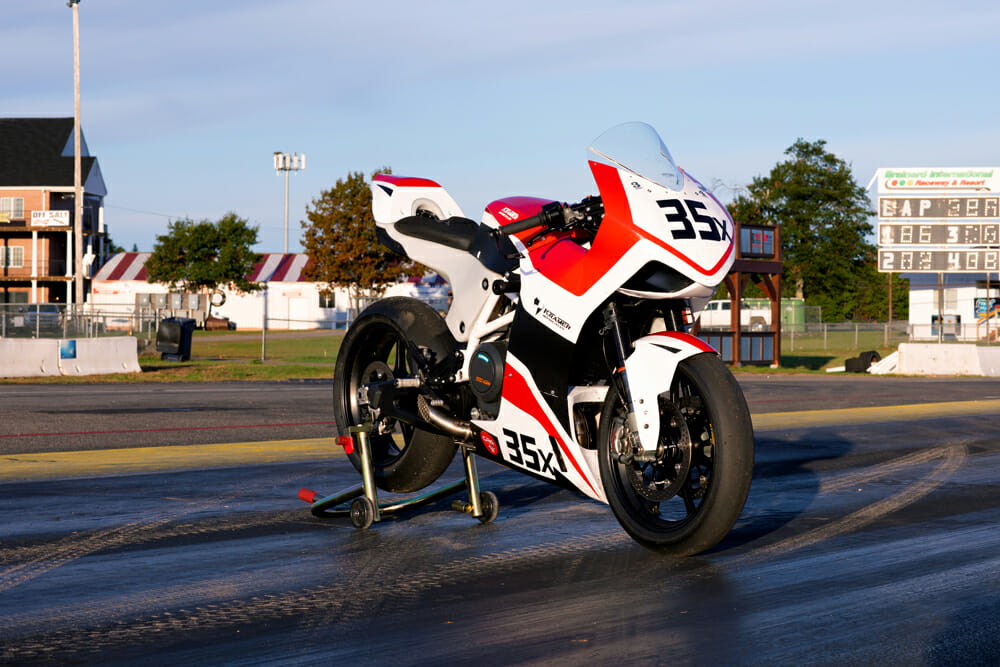 Skinny, svelte and oh-so-light, the Krämer comes loaded with goodies like Dymag wheels and an AIM data-logging system.
Skinny, svelte and oh-so-light, the Krämer comes loaded with goodies like Dymag wheels and an AIM data-logging system.
An equivalent production machine in terms of performance would likely be a Twins Cup racer, which, if you wanted to build into a class contender, you’ll be unlikely to see much change out of $18-20,000 when all is said and done.
The 1990s craze for Supermono racing—a class designed for road racing machines with single-cylinder four-stroke engines—never really died out in Europe as it did everywhere else. The class was an engineer’s playground, with grids dotted by home-built specials or ex-Grand Prix 125/250cc chassis sporting motors like Yamaha’s 660 single-cylinder SZR or Honda’s XR650.
The most famous of the racing Supermonos was undoubtedly the Ducati Supermono, which fetches incredible money these days for an original in good condition, in some cases well over $100,000.
This is the ground the Krämer plays in. Supermono racing represents some of the most enjoyable, cost effective road racing you can undertake—especially considering these machines don’t rip through tires like a supersport or superbike can. Supermonos challenge your riding by putting it under a microscope. You don’t have the horsepower underneath you to fix the corner you just screwed up—it’s all about maintaining corner speed and overall flow—and this is something a Krämer does better than almost any bike I’ve ever ridden.
It may be a single-cylinder racer, but the Krämer produces such prodigious corner speed and thus fast lap times that it is more than competitive against Twins Cup racers, which opens up many classes for Krämers to compete in the U.S.
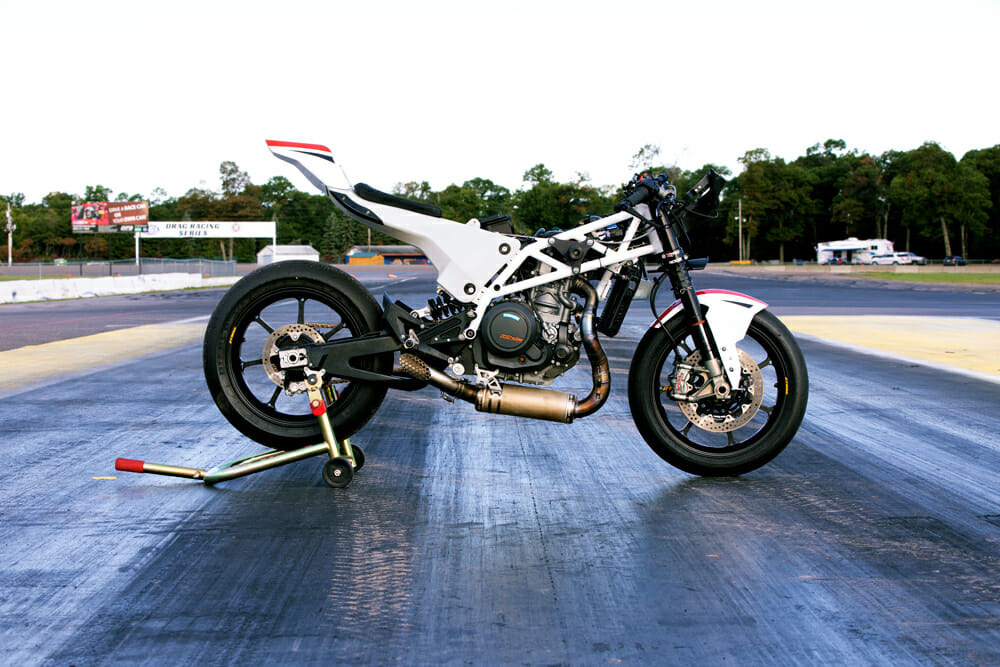 With the fairings off, it’s easy to see just how trim the Krämer really is. Ready to race with a full tank of gas it only weighs 276 pounds.
With the fairings off, it’s easy to see just how trim the Krämer really is. Ready to race with a full tank of gas it only weighs 276 pounds.
Krämer Motorcycles are imported into the U.S. by young couple Joe Karvonen and his wife, Brittany Taplin, out of their Sisufab workshop in Fargo, North Dakota. An odd place, I’ll grant you, for some of the most potent racing motorcycles in the country to call home, but Joe and Brittany are firm believers in the Krämer concept as a machine designed for racers who want something different.
“The big restriction always is price, and we understand that. It’s not for everyone,” Joe says with a refreshing honesty. “These are pure racing motorcycles—they haven’t been modified from a production machine in any way. But having said that, the uptake in the U.S. has been great. We started importing them in 2015 with just a single unit, and by late 2016 we had 10 units in the U.S. They went everywhere.
“That fall is when we started pushing a little bit harder to get things moving and gain some momentum. Then in 2018 we really saw an uptick in sales. Now for 2019, we have multiple dealers underneath the Krämer Motorcycles USA division. We have a West Coast dealer, Pacific Northwest, a New England area dealer, one in Florida, and we’re trying to get one in the Southwest. It’s been a very steady growth path for the USA side.”
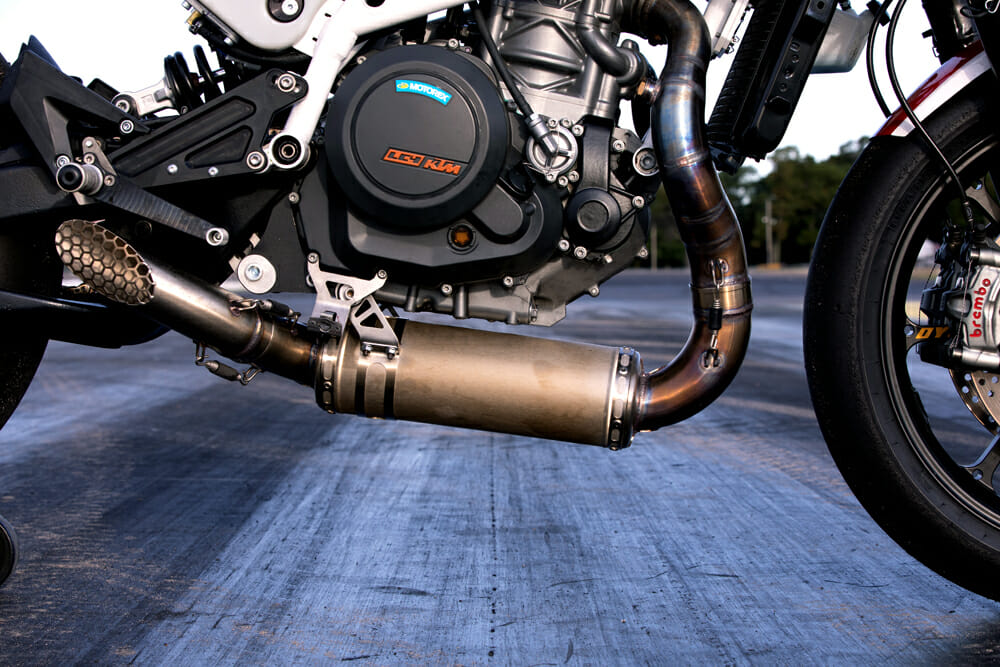 The SST Racing exhaust is both beautiful and extremely, but gloriously, loud.
The SST Racing exhaust is both beautiful and extremely, but gloriously, loud.
Delving Into The Krämer HKR-EVO2 R
The Krämer HKR-EVO2 R builds on the platform of the EVO1 and EVO2 machines, using an updated single-piece Chromium-Molybdenum steel trellis frame mated to an aluminum swingarm that runs on Dymag UP7X 17 x 3.5 front and 17 x 5.5 rear forged wheels.
“It’s a very simple chassis, but what is unique about it is the fixture point is the pivot shaft for the rear of the engine, for the swingarm and main frame,” says Joe. “The front of the engine is located on the standard engine mounts for the KTM 690 motor, but our front engine mounts are floating.
“Inside the frame there’s floating inserts that allow the chassis to flex more. This way, you can get more torsional and lateral flex out of the chassis because of that engine-mounting configuration.
“There’s no top engine mount, either. Just a front and back mount. The front mount is floating. It was proven to be the best solution when it came to chassis dynamics.”
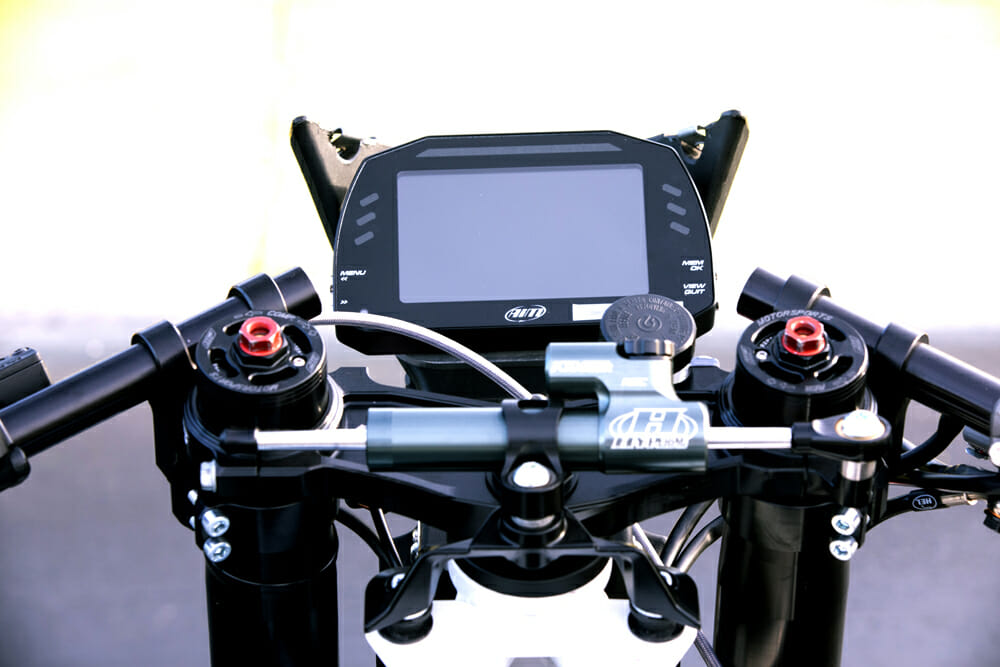 AIM dash logs GPS data, rpm, water temp, gear position, and vehicle speed.
AIM dash logs GPS data, rpm, water temp, gear position, and vehicle speed.
The golden rule with racing motorcycles is to have the optimum balance front and rear, and much of this problem is dictated by the fuel and where its placed on the motorcycle. Many engineers get around this problem by putting the fuel tank under the seat so as to keep the distribution even as the fuel load goes down, but Krämer takes things in a different direction. On a Krämer HKR-EVO2 R (or any Kramer for that matter), the fuel tank triples as the place where the fuel goes, the subframe, and where the rider sits. It’s all one unit.
“It is all structural,” says Joe. “The tank is made of XPE plastic and works to support the rider and house 3.17 gallons of fuel. We use this multi-use approach because reduces weight and makes for a more compact package.
“There’s no reinforcements to it. It’s all plastic and really, really, strong. It has built-in crash protection on it down the edges of the tank, about where the backs of your thighs go. These impact before anything else.
“The fuel tank is something people ask about all the time. It hasn’t changed. It’s been the same design since day one. The thing is bulletproof. We get asked a lot if they break? We haven’t broken one. It’s not from a lack of trying, either. These things have hit the ground a couple times!
“Also, our tail cap covers up the ventilation system to the fuel tank. We have a quarter-turn quick fill behind the rider seat, which is nice. It’s a quick, easy way to fill it. We offer the tank in two colors—black and translucent. The black looks great but it’s a little hard to see your fuel level, so when we’re racing we tend to run translucent tanks.”
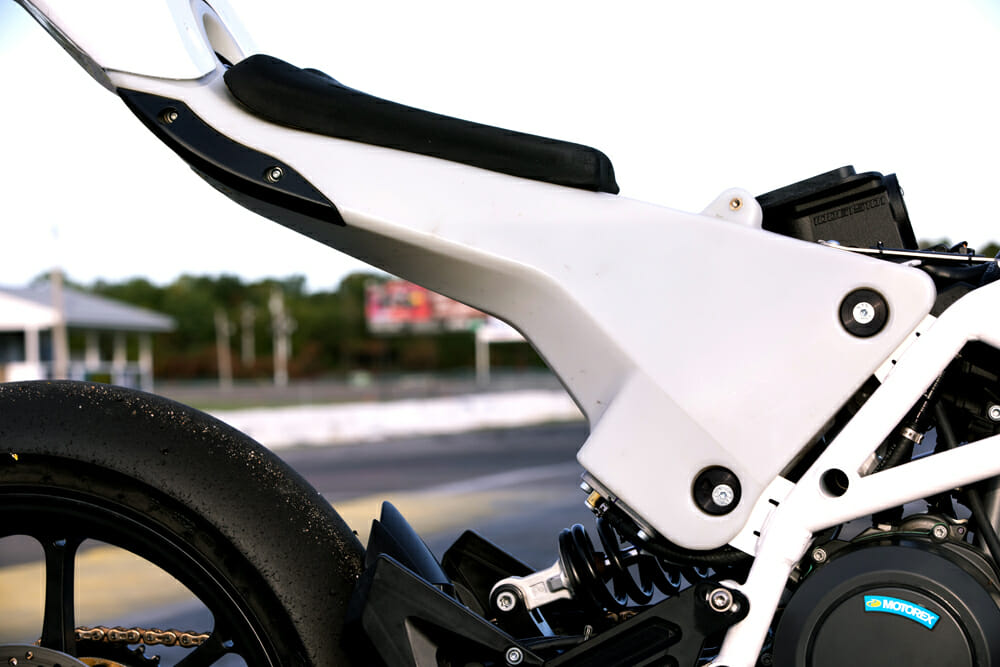 One of the Krämer’s key features is a subframe that also doubles as the gas tank and rider seat. The company says it has not had a single fault with the plastic design.
One of the Krämer’s key features is a subframe that also doubles as the gas tank and rider seat. The company says it has not had a single fault with the plastic design.
The Krämer HKR-EVO2 R runs suspension originally designed for the KTM RC8 R (the machine Markus Kramer helped design during his time at KTM) in the 43mm WP Super Sport inverted closed chamber fork and WP race shock with a KMC Link system and adjustable ride height.
“The RC8 R front end is where the numbers came for fork length and fork offset, things like that,” says Joe. “So, it was easy to get set up and get working early on. Through the HKR evolution, we’ve added things like adjustable offset triple-clamps on the S and the R spec now.”
Braking is the domain of a 19 x 19 Accossato master-cylinder and Brembo’s dual M50 front calipers gripping 290mm full floating discs up front, with a Formula two-piston caliper biting a 220mm disc at the rear.
“The nice thing with the M50’s is not only are they a great calipers, but they’re a million pad options for them,” says Joe. “You can really tailor them to whatever the rider’s preference is. For the R spec, we really like it because you can put a soft pad in and it’s adequate. It mounts brakes with not a lot of bite, or if you want a ton of bite you can have all the brakes in the world.”
On the engine side, the HKR-EVO2 R runs the latest generation KTM 690 Duke single-cylinder motor that came out at the end of 2015.
“That’s been a big improvement. It’s a brilliant drive train,” says Joe. “It’s been really bulletproof for us. Its vibration is nothing like people expect it to be, especially for a big single. It’s exceptionally smooth. It is a stock KTM engine. We have not done any modifications to the engine itself. All of the extra power we make is through airbox and exhaust optimization along with ECU calibrations.”
This particular Krämer HKR-EVO2 R came with an AIM dash and data logging system that allowed the team to figure out where I was fast and slow, and flashed lap times up on the dash.
“As for the AIM data logging system, at this point for the EVO2 the AIM dash is still in development stage. The standard AIM dash logs GPS and acceleration data. The bike you see here is also logging rpm, water temp, gear position, and vehicle speed.”
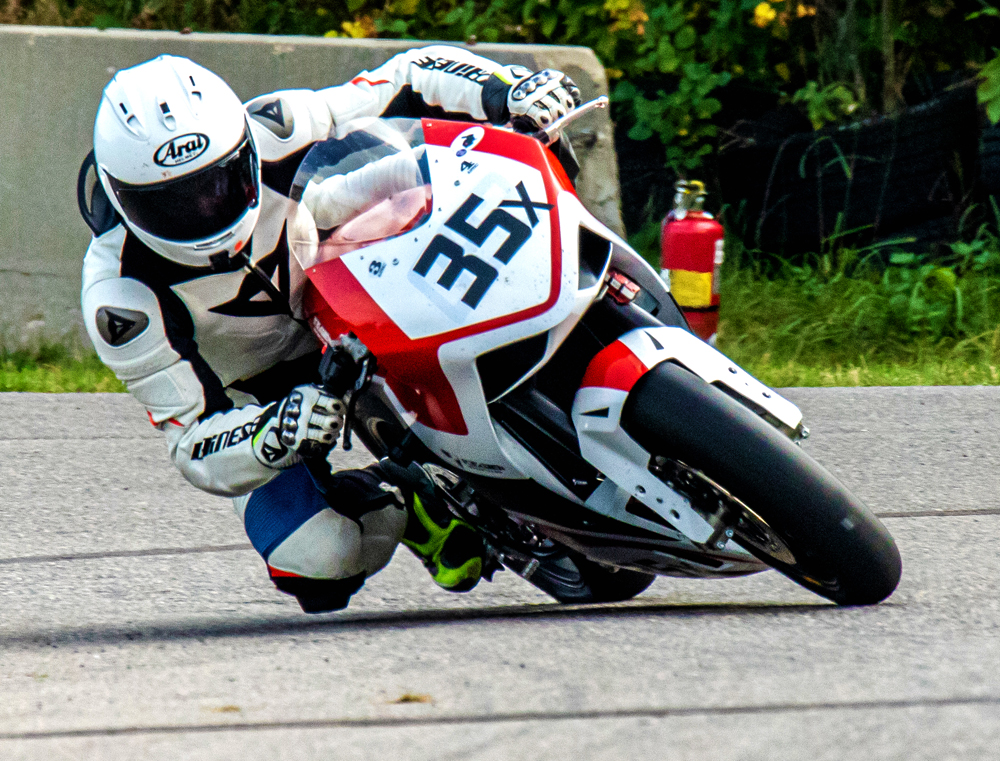 Bank the Krämer into the corner has hard as you dare and the long wheelbase will give you supreme stability.
Bank the Krämer into the corner has hard as you dare and the long wheelbase will give you supreme stability.
Testing The Krämer HKR-EVO2 R
It’s always a good day when you get to throw your leg over a pure racing motorcycle. Nearly all my racing is done on production machinery, with all the concessions that come with them, and I haven’t ridden a proper ground-up race bike for over a decade.
The Krämer feels unlike any bike I’ve ever ridden, and not because it steers with such precision. I’ve ridden 250cc Grand Prix bikes before, and they have a similar turn speed to the Krämer. The difference is how physically big the Krämer is.
When you first sit on a Krämer, you’ll be amazed at the room you have at your disposal. The tall 32.2-inch seat feels like it’s about five inches longer than my Pikes Peak Aprilia and gives you so much room to move about, almost too much, in that you can slide back further than you’d like on acceleration and thus take more weight off the front than intended.
The peg placement is like the position of a 1098 Ducati with plenty of range, although the cockpit position is set much higher than the old Italian superbike with the bars wide—almost like a nakedbike.
All this extra room takes a little time to get accustomed to, especially if you’re used to the cramped riding position of a current generation supersport machine, but give it three laps and it’s amazing how quickly you become comfortable with the way the Krämer rides.
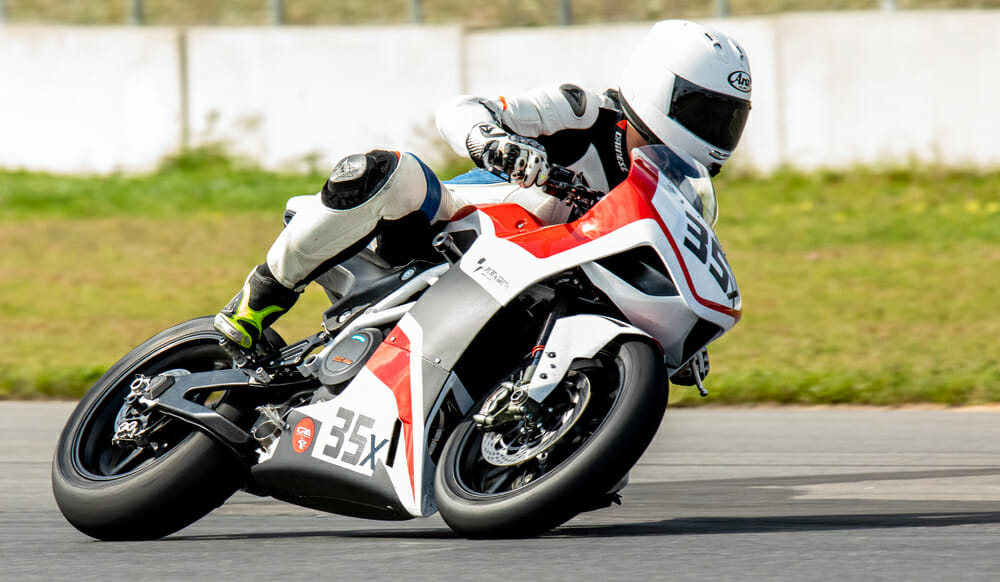 Early into the race, Rennie got the Krämer boys up to a one lap lead.
Early into the race, Rennie got the Krämer boys up to a one lap lead.
Put simply, the Krämer HKR-EVO2 R turns with the kind of speed normally reserved for GP machines. With a ready-to-race weight of just 276 lb, the Krämer will go from bolt upright to on its side faster than almost any motorcycle with a fairing I’ve ever ridden, especially given the rather rangy 1400 mm/55.11-inch wheelbase. Turn speed is amazing, but so is the feedback you get from the front end and because of that wheelbase, the stability.
The Krämer guys have engineered a level of feedback into the front of the HKR-EVO2 R many other bikes can only dream of. You can absolutely bury the front end under braking—during my race laps (especially in the sprint races) I would simply wait until the guys around me started to brake, then leave it on some more before slamming on the anchors. Never did the HKR-EVO2 R get out of shape on the brakes. It would simply follow the line I chose, be it the right or wrong one, and track its way around the corner.
And should you get into a corner too hot or miss your braking marker, the HKR-EVO2 R will happily allow you to dial in more front brake and pull yourself into the apex without losing too much time or overstressig the front tire.
A lot of this is due to the lack of mass underneath you. Indeed, I weigh about 67 percent what the entire bike weighs, ready to race. So, you can imagine how good the bike will be with someone a little lighter than me on board.
The combination of strong but controllable bite from the front brakes helps here, too. There’s lots of braking power on offer, but it’s matched by a smooth and progressive feel at the Accossato master-cylinder, allowing you to dial the exact amount of brake you want.
Switching attention to the KTM 690 Duke single-cylinder motor, you’ve got about 80 hp at your disposal which doesn’t seem like a lot but will get you around Brainerd within 10 seconds of a Superbike—and that’s with a full mile-long front straight.
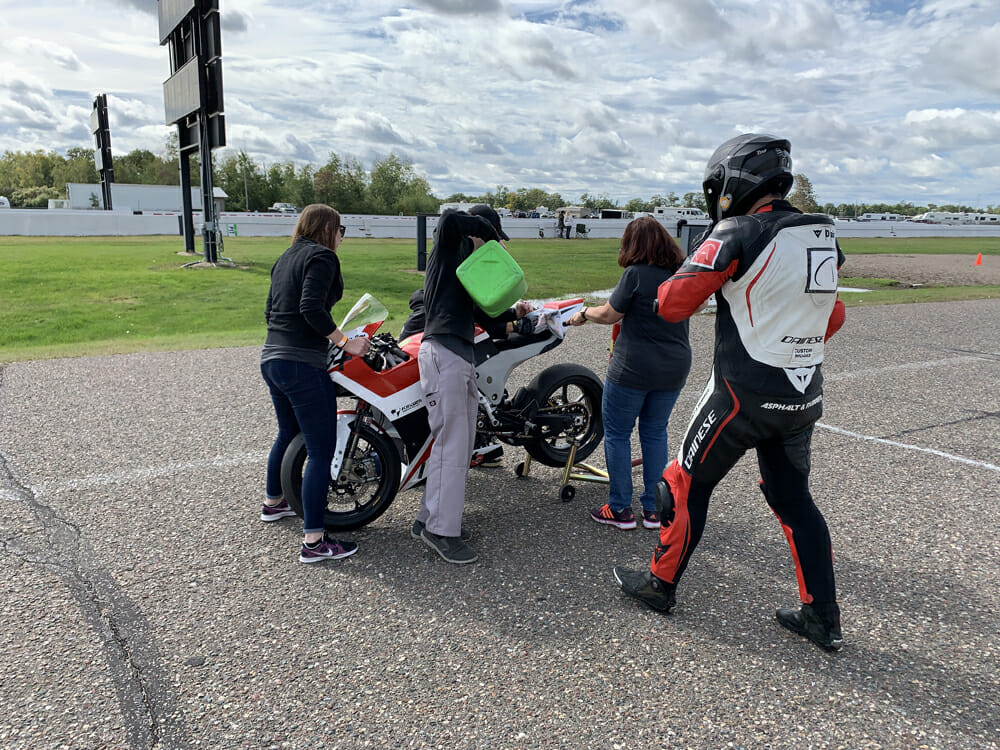 Asphalt and Rubber’s Jensen Beeler gets ready for his stint.
Asphalt and Rubber’s Jensen Beeler gets ready for his stint.
The modifications carried out by Krämer do give some extra pep off the corners, but it’s more apparent in the mid-to top-end, as the big single is still making (some) power right up to the redline of 9500 rpm.
It’s best to shift about 500 rpm before that mark and keep the motor spinning high and the gorgeous SST Racing exhaust singing, but not too high. You still have to be on it to get the most performance out of the single: drop the revs below 5000 rpm and it will still go, but nowhere near the level required for fast lap times.
The Duke’s six speed gearbox is matched to a development module for the up and down/autoblip quickshifter that works surprisingly well for a gearbox that was never intended to house one.
I would still blip the throttle on downshifts purely out of habit, but was later told that as long as I didn’t use the clutch (an APTC slipper clutch for those of you playing at home), the autoblip system would override anything I was doing on the downshift.
The Krämer HKR-EVO2 R is a spectacular little machine, I guess you’d want it to be for the price. But, as we’ve outlined earlier, this a turn-key race bike, and a bespoke one at that. A Twins Cup racer feels like a truck in comparison to this—yes, it has more power—but those extra ponies won’t do you much good when a Krämer rails past you around the outside.
On another note, it’s excellent to see the spirit of engineering still alive in small capacity racing. We can all drool over the beautiful chassis’ in the GP paddock, but those are going to cost you way more than a Krämer. Plus, as long as it’s looked after, the Krämer will be a competitive racer for years to come.
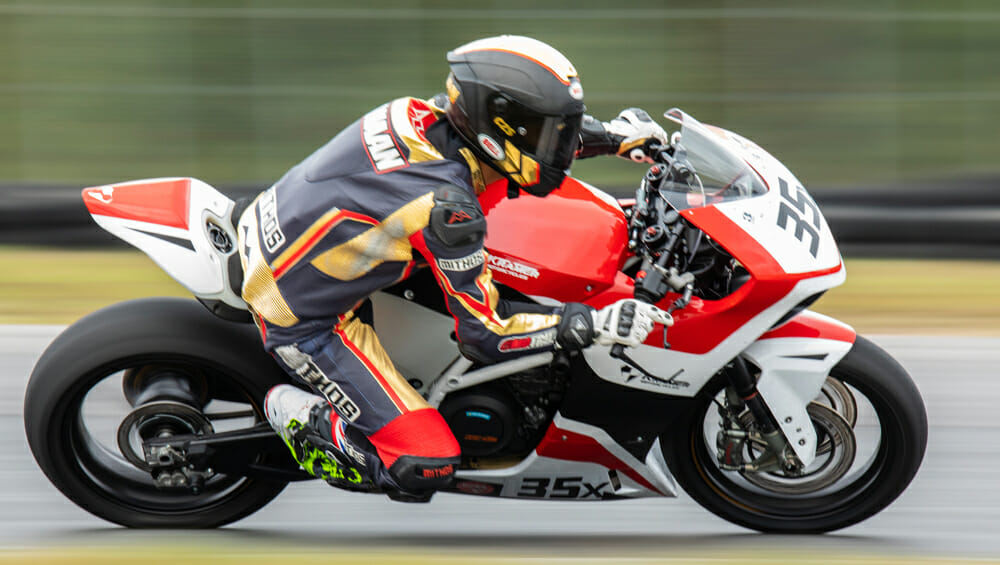 Troy Siahaan of motorcycle.com hard at work in the fourth hour.
Troy Siahaan of motorcycle.com hard at work in the fourth hour.
Race Time on the Krämer HKR-EVO2 R
As part of a team that included myself from Cycle News, Motorcycle.com’s Troy Siahaan, Asphaltandrubber.com’s Jensen Beeler, and local fast guy Kris Skellenger, we were handed the keys to a new Krämer HKR-EVO2 R to try and take a class win (GP2) in the Central Roadracing Association 5 Hour, as well as three sprint races at Brainerd in Minnesota.
For those with long memories, Brainerd was the scene of the first-ever WorldSBK race, held in 1989. Housing a one mile drag strip, there’s plenty of time on a Kramer to make sure you’re in the right position to attack one of the most fearsome corners anywhere in the world of turn one—an absolutely flat out right hand tilt on a Kramer, but on a Superbike, your entry speed is close to 170 mph—making it a true test of your mettle.
With three sprint races on Saturday, there was plenty of time to get acquainted to the Krämer’s personality, and suffice to say we got along great with three wins and a new class lap record of 1:50.61 on the Brainerd Long Course.
Come Sunday, the 5 Hour would be a case staying upright and keeping out of the Superbike’s way while also staying in front of a second Krämer, the number three bike ridden by Brad Kreller, Christian Schmidt, Kurt Ohnsorg, and Jon Champ.
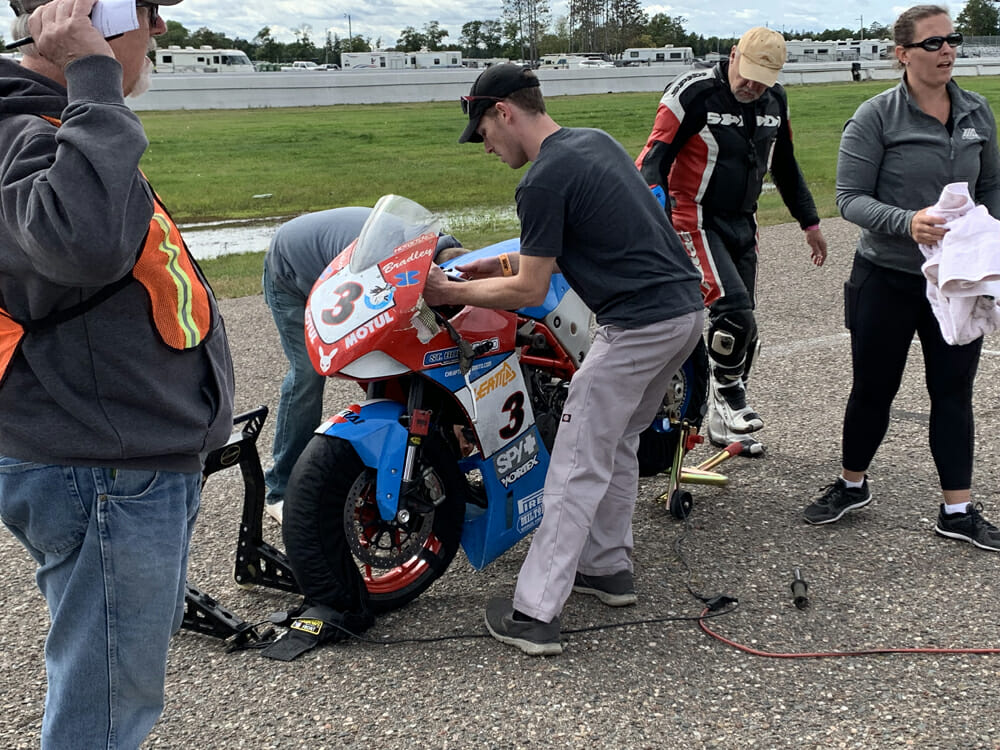 Our team manager Joe attends to the competition’s Krämer. I guess he has to, being the importer and all.
Our team manager Joe attends to the competition’s Krämer. I guess he has to, being the importer and all.
I started off first and managed to build a lead of two laps after the #3-bike pitted early and then had a ride through penalty for speeding in pit lane. Handing the bike to Troy after 45 minutes, he dutifully kept the lead going and gave the bike to Jensen, who was on the bike when a red flag came out for a bike blowing up at top speed going into turn one, losing us ¾ of a lap in our lead as the field restarted.
By hour three, Kris was in control, until he wasn’t, crashing at turn four. He got the bike back to the pits, losing a total of seven minutes by the time I was given back the bike for my second stint.
At this stage, we were second in class and I was thoroughly pissed off. Luckily, we were on the same lap as the #3 Kramer, and by the next round of stops were back in the lead after I put in a series of 1:50.1-second laps.
Yet more problems came the way of the #3, and we had a new problem—a Yamaha YZF600 with a tank about as big as a Ford Raptor’s. That meant they had to only stop once per every two of ours, but we were still 10 seconds per lap faster and eventually Troy got us back in the lead by our last stop.
It was decided for me to bring the bike home, and I got the team one lap up on the Super Tanker to cruise home and take the GP2 class win. We also placed fifth overall.
Amazingly, we used the same set of Pirelli Super Corsa SC1 front and SC2 rear slick tires all race, although the front was absolutely shot by the end of the five hours.
What a day. Thanks very much to the guys at Kramer Motorcycles USA, Ben and Joe, plus Joe’s wife Brittany for the amazing support during the weekend. Same time next year, guys? CN
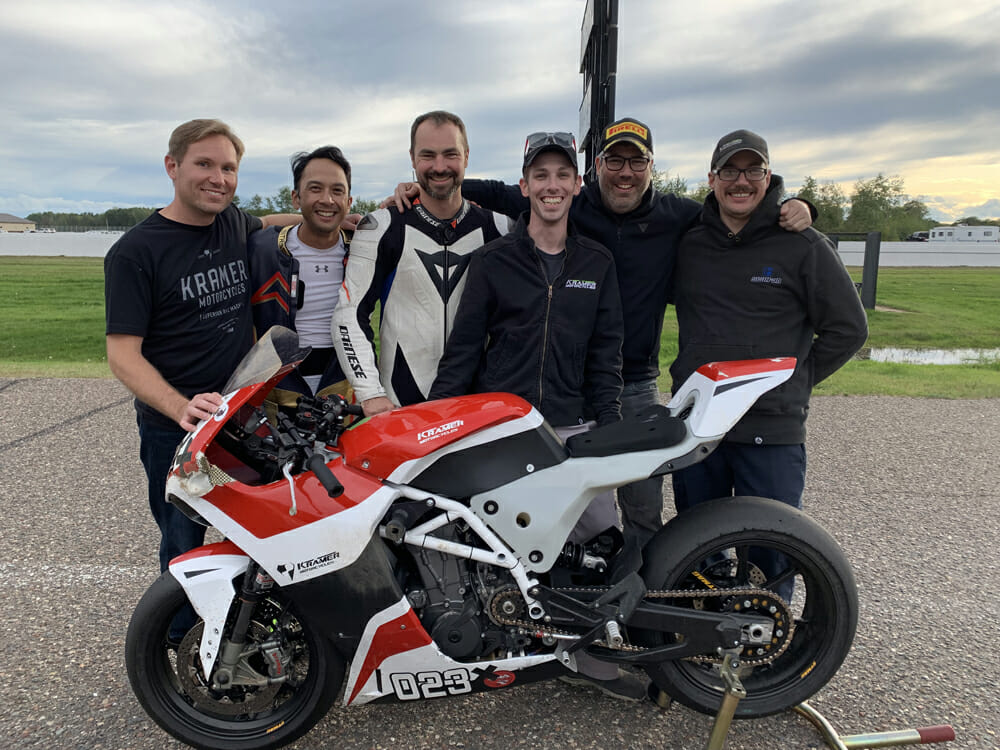 Winners are grinners! Team Krämer USA from left: Kris Skellenger, Troy Siahaan, Rennie, team manager Joe, Jensen and mechanic, Ben.
Winners are grinners! Team Krämer USA from left: Kris Skellenger, Troy Siahaan, Rennie, team manager Joe, Jensen and mechanic, Ben.
2019 Krämer HKR EVO2 R Specifications
| MSRP |
$22,495 |
| Engine: |
Liquid-cooled, single-cylinder, 4-stroke |
| Displacement: |
690cc |
| Bore x stroke: |
105 x 80mm |
| Fuel injection: |
Electronic fuel-injection system |
| Transmission: |
6-speed, quickshifter-equipped |
| Clutch: |
Wet, Multiplate, slipper |
| Chassis: |
Chromium-Molybdenum steel trellis frame, powder-coated |
| Front suspension: |
43mm WP Super Sport forks, closed cartridge, fully adjustable |
| Rear suspension: |
WP monoshock, fully adjustable |
| Front brake: |
Dual 290mm full floating rotors, Brembo M50 four-piston radially-mounted monobloc calipers |
| Rear brake: |
Single 220mm rotor with Formula 2-piston, cast 1-piece caliper |
| Front wheel: |
Dymag UP7X 17 x 3.5 in. forged aluminum |
| Rear wheel: |
Dymag UP7X 17 x 5.5 in. forged aluminum |
| Wheelbase: |
55.1 in. |
| Seat height: |
32.2-33.6 in. |
| Fuel capacity: |
3.17 gal |
| Weight (claimed): |
276 lbs. |
